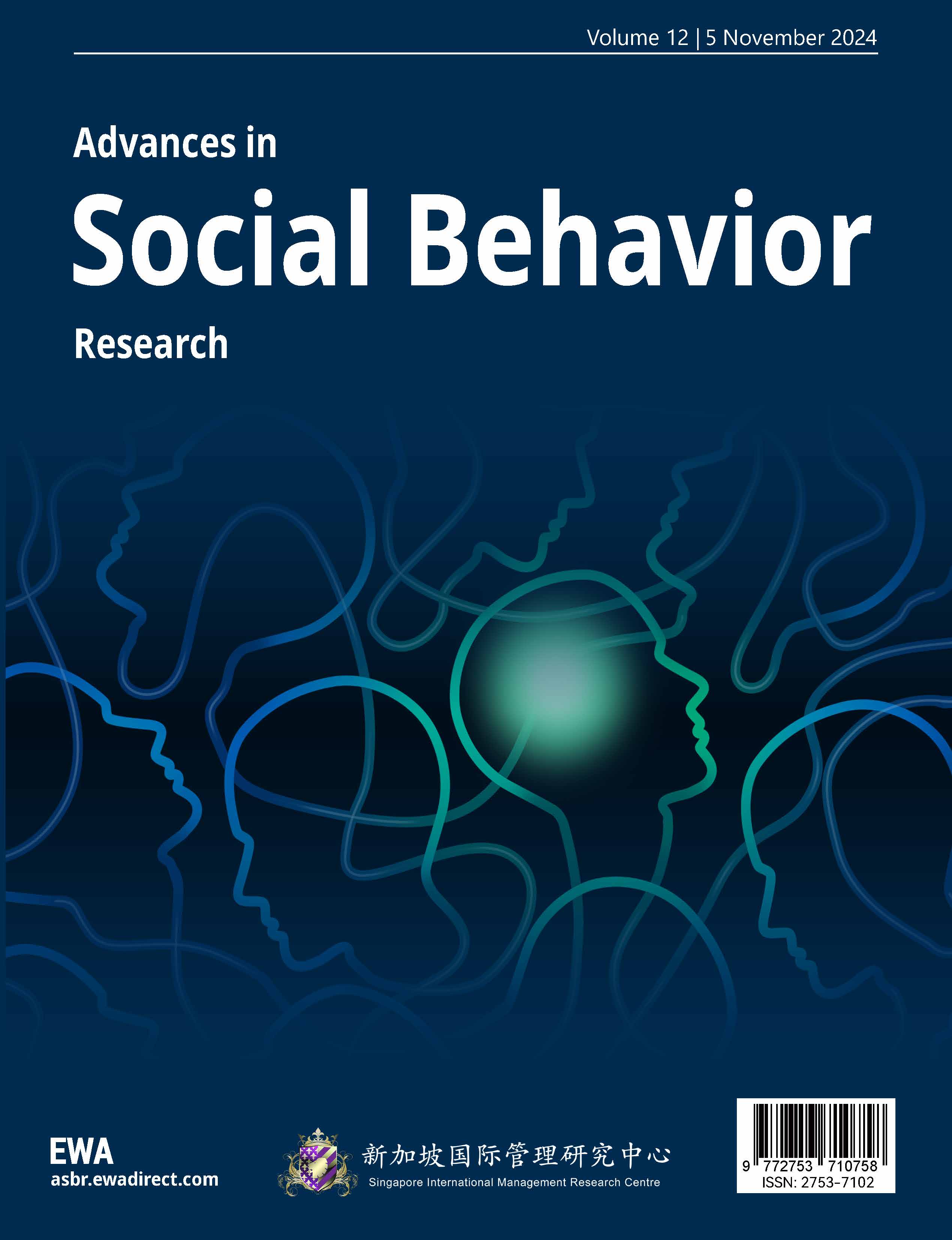1. Introduction
During adolescence, high school students exhibit heightened self-awareness and increased emotional fluctuations. This study investigates the challenges students face due to academic performance variations—such as self-doubt and demotivation—by examining the background, content, implementation, and outcomes of a practical initiative. Specifically, it explores the use of drawing as a stress-relief method to promote clearer self-awareness and psychological motivation.
2. Background of the practice
The high school years represent a critical stage of rapid physical and psychological development, marked by sequential progress from physiological self to social self, and ultimately to psychological self. As students enter high school, they encounter increased academic pressure, extended school hours, and—for many—their first experience with dormitory living, which may trigger anxiety and emotional stress. This is particularly pronounced during the first year of high school. In this context, the need for psychological guidance activities during class meetings becomes increasingly important [1].
By the second semester of the first year, students have spent a full term adapting to their studies and social environment. They have developed learning habits and become familiar with their teachers’ personalities. Despite the looming pressure of four standardized subject exams, many students begin to relax their standards and show signs of disengagement. At this juncture, these students require a new spark to reignite their motivation and dreams [2].
In response, the author initiated a theme-based class meeting on “self-awareness” at the beginning of the second semester, titled "Hello, Let’s Reacquaint Ourselves", using the format of four-panel comics. The objective was to stimulate students’ curiosity, reinforce peer interaction and support, and promote clearer self-perception. This activity was followed by semester-long evaluations, where each student presented and explained the meaning behind their own comic. Subject teachers were invited to provide feedback. In this open and supportive environment, students engaged in self-assessment, peer evaluation, and teacher-guided reflection, which collectively fostered self-awareness, strengthened peer collaboration, and supported individual development—ultimately establishing a mutually beneficial learning community.
3. Overview of the “four-panel comic”
The “four-panel comic” consists of four simple sketches drawn on a blank sheet of paper. While content may vary, such comics are commonly used in team-building or ice-breaking activities as a form of self-introduction. For this activity, the comic themes were designed based on the author’s experience and training in psychology. The four panels included: Three personal labels (top-left); One’s ideal self at the end of the semester (top-right); A personal highlight moment (bottom-left); A representation of one’s current state using water as a metaphor (bottom-right). An example is shown in Figure 1.
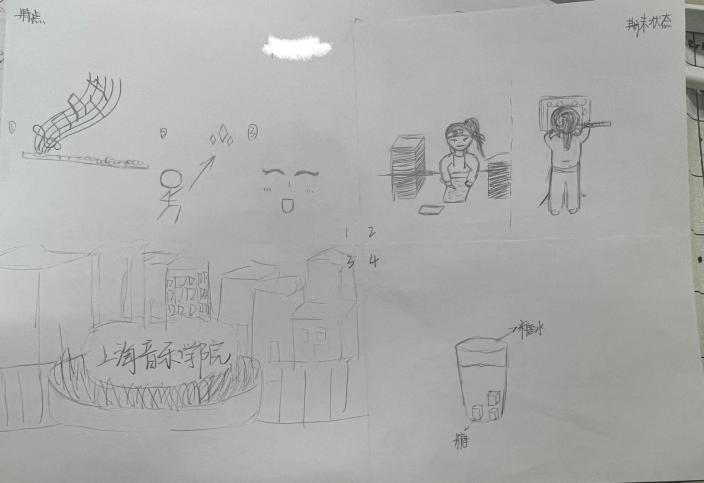
3.1. Three personal labels
Using “three labels” is a popular method for ice-breaking in team-building contexts. For students in their second semester of high school, this approach felt fresh and novel. By this point, students had generally built close friendships, but may still lack deep understanding of each other’s personalities and inner thoughts. For some introverted and sensitive students, their self-awareness is largely shaped by others’ feedback. Summarizing and selecting three labels helped students gain a more coherent understanding of themselves.
3.2. My ideal self at semester’s end
Aligned with the goals of quality-oriented education, high school aims to cultivate not only students’ academic knowledge but also their moral awareness and character development [3]. Between one’s current state and future outcomes lies a process governed by moral discipline. The second panel of the comic invited students to envision and draw their ideal selves at the end of the semester, encouraging them to express self-expectations and personal aspirations through art.
3.3. Highlight moment
A highlight moment refers to a point of greatest personal achievement or pride. Anticipating that some students might find it difficult to articulate or identify such a moment (a prediction later validated by the results), the activity allowed flexibility—students could depict either a past accomplishment or a future moment they most anticipated and hoped to achieve. This panel aimed to foster students’ self-acknowledgment and confidence. A highlight moment refers to a point of greatest personal achievement or pride. Anticipating that some students might find it difficult to articulate or identify such a moment (a prediction later validated by the results), the activity allowed flexibility—students could depict either a past accomplishment or a future moment they most anticipated and hoped to achieve. This panel aimed to foster students’ self-acknowledgment and confidence.
3.4. Representing one’s state through water
Describing one’s state abstractly can be difficult and unfocused. To provide structure and clarity, the fourth panel required students to metaphorically depict their current state using the characteristics of water. This offered both direction and creative freedom. The resulting drawings demonstrated a wide range of thoughtful and imaginative interpretations, reflecting students’ introspection and expressive abilities.
4. Implementation and follow-up of the “four-panel comic” activity
4.1. Activity implementation
At the first-class meeting of the second semester of the 2021–2022 academic year, the author launched this teaching practice in the class under their instruction. Each student received a blank sheet of paper, and after a brief explanation of the four sections, the remainder of the session was left entirely to the students.
During the initial 10 minutes, students were caught between excitement and confusion. This novel “mini-game” quickly captured their attention. Once the meaning of each panel was clarified, they eagerly began drawing, channeling their enthusiasm onto the blank page.
Out of the 40-minute class session, approximately 35 minutes were devoted to drawing. Most students submitted their comics before the end of the class. About one-ninth of the students finished early, while around one-sixth did not complete their drawings in time and submitted them the following day.
4.2. Self-presentation, teacher feedback, and peer evaluation
In the month that followed, students were invited to share their four-panel comics one by one during morning reading sessions and class meetings. Subject teachers were also invited at appropriate times to attend and provide comments and feedback.
4.3. Sample content and analysis
In the first panel—“Three Personal Labels”—a single label such as “love for music” was represented in diverse ways, including musical notes, sheet music, specific instruments, and singing, as shown in Figure 2(a), (b) and (d). Interestingly, the same symbol could express different meanings. For example, in Figure 2(c), a student used sheet music to symbolize “reliability”—a thoughtful and creative interpretation. This panel allowed students to summarize their self-perceived traits based on personal interests and feedback from others, offering valuable insight into personality development and social interaction.
In the “Semester-End Self” panel, a clear gender difference emerged. Most boys focused on expressing their motivational state with phrases like “Charge forward!” or “YYDS” (Internet slang meaning “Forever the Best”), whereas most girls visualized concrete academic outcomes, such as “passing the exams.” This suggests that girls may focus more specifically on academic goals at the semester’s end. In the “Semester-End Self” panel, a clear gender difference emerged. Most boys focused on expressing their motivational state with phrases like “Charge forward!” or “YYDS” (Internet slang meaning “Forever the Best”), whereas most girls visualized concrete academic outcomes, such as “passing the exams.” This suggests that girls may focus more specifically on academic goals at the semester’s end.
In the “Highlight Moment” panel, more than half the students depicted their aspiration of being admitted to their desired university in two years, as shown in Figure 3. During presentations, students also mentioned the motivating influence of “role models,” a dimension not easily observed in daily school life. Other students showcased a wide range of personal highlights—playing basketball, performing on stage, drumming, and more. The author believes every student possesses unique strengths, some of which they may not yet have discovered. This realization offers inspiration for designing future teaching practices.
In the final panel, “Current State Expressed Through Water”, students created whimsical and imaginative depictions—water in cups, rivers, lakes, oceans, waterfalls, single droplets, whirlpools, sugary water, iced water, and more. These visuals were both creative and endearing. The author combined this panel with the “Semester-End Self” to encourage students to reflect on the adjustments and efforts needed to progress from their current state to their ideal future selves. One student’s depiction of toilet water drew particular attention. Based on this and in consideration of the student’s regular behavior and personality, the teacher collaborated with subject teachers to design targeted activities aimed at fostering self-recognition and reawakening interest in learning. These interventions noticeably boosted the student’s engagement and vitality.
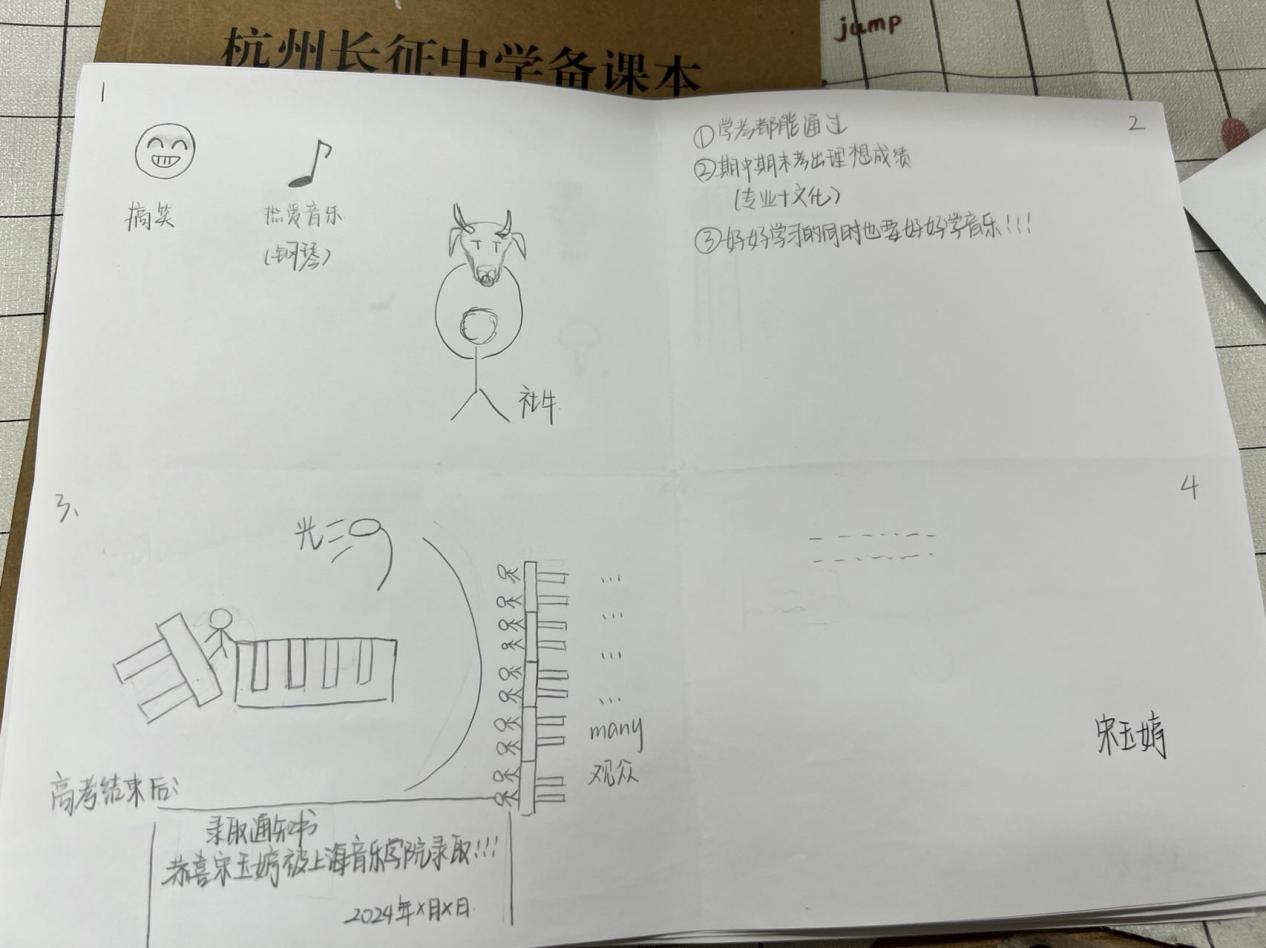
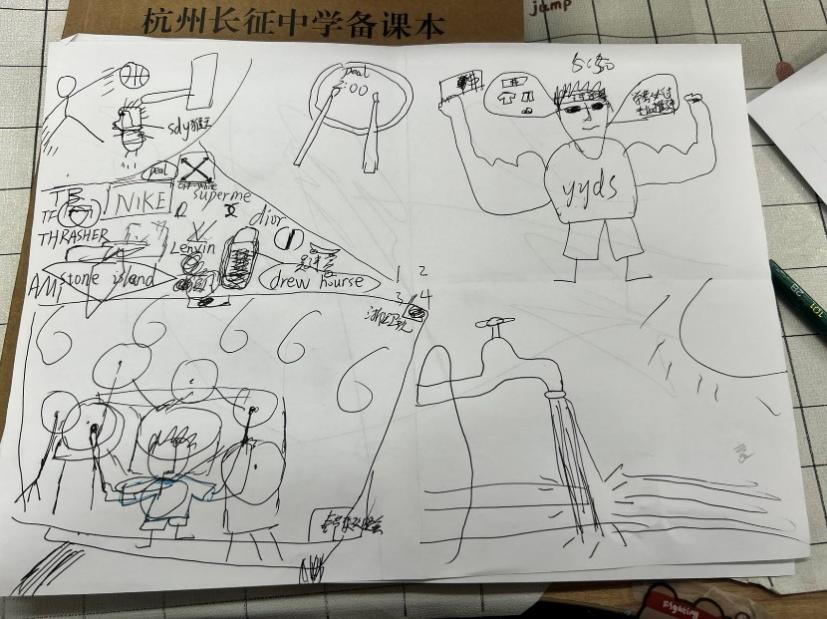
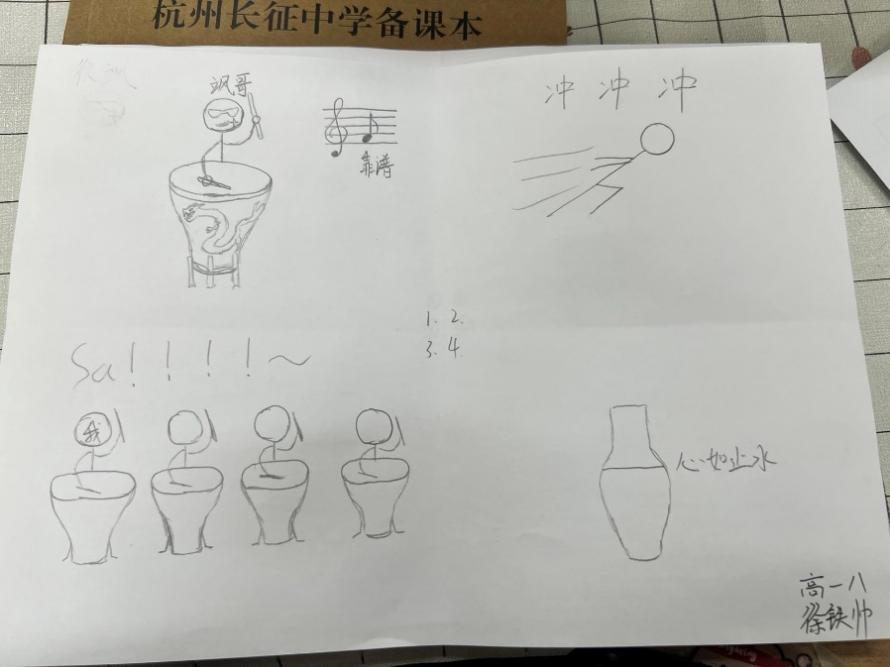
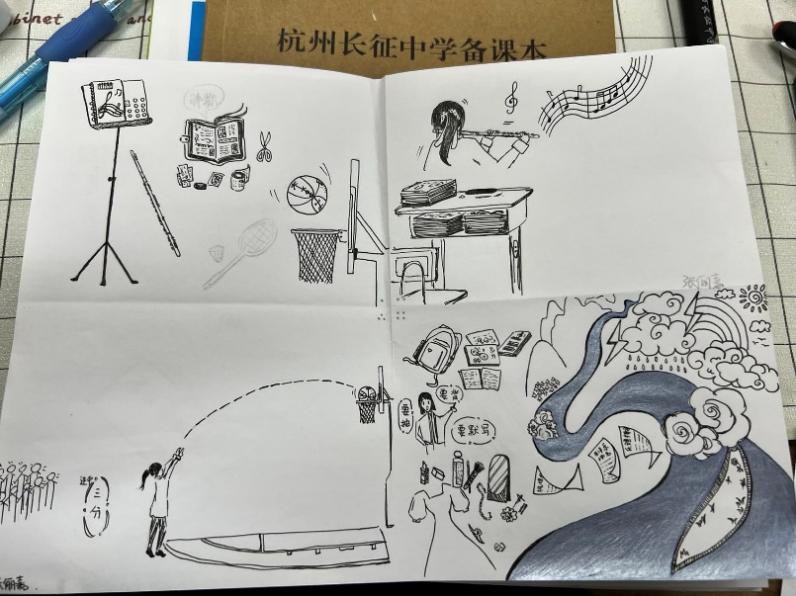
Figure 2. Four-panel comics on“love for music”
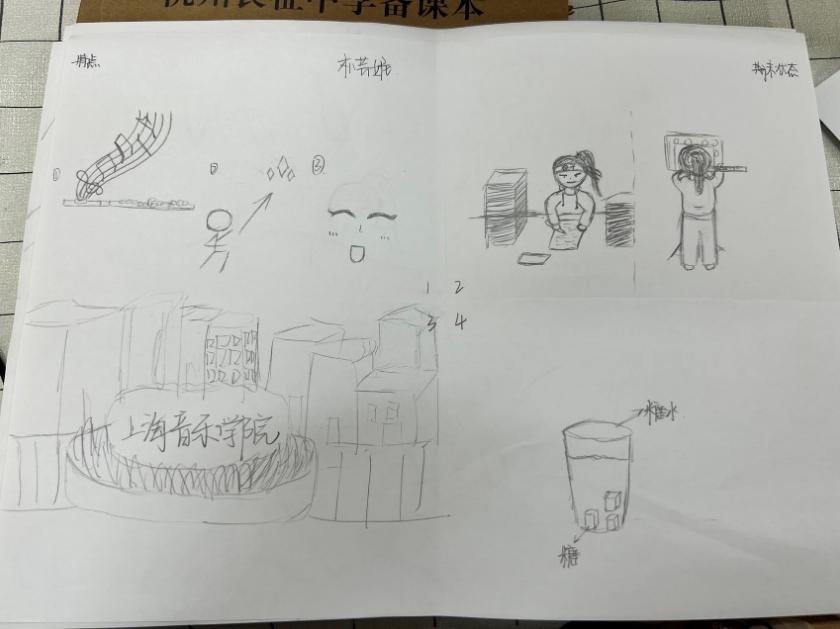
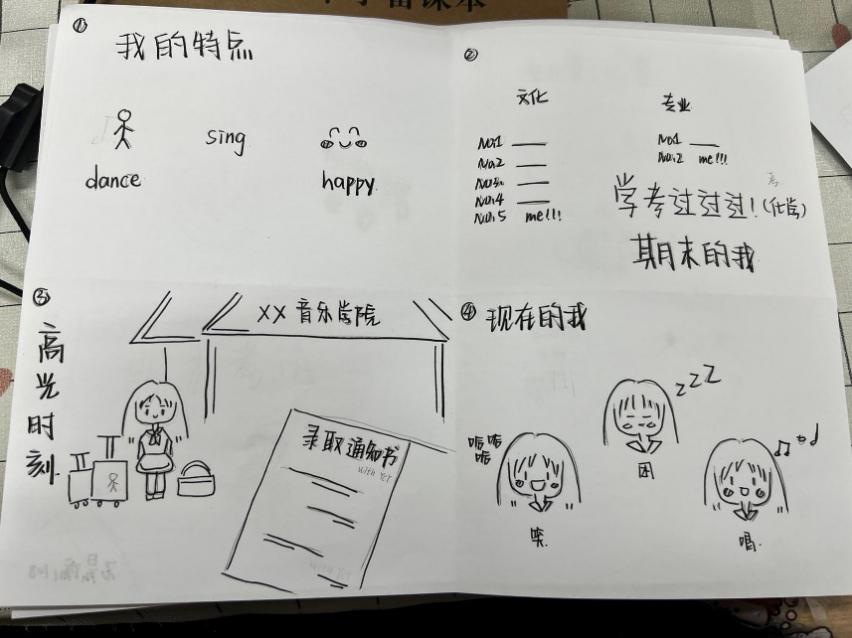
Figure 3. Highlight moment
5. Conclusion and insights
This modest teaching experiment served not only as a moral education activity during a class meeting, but also as an opportunity for each student to analyze and articulate their inner world—effectively providing a window into their psychological well-being. The outcomes exceeded the author’s expectations, and deep appreciation is extended to all the students for their sincere participation and heartfelt sharing. Drawing on student feedback and teacher commentary throughout the activity and the follow-up evaluations, the author offers the following key insights:
5.1. Some students exhibit a strong pursuit of perfection
Drawing is a vital form of self-expression. When examining students’ artwork, teachers should not only focus on the final product but also consider the creative process—how ideas are formed, structured, and expressed. In this activity, some students demonstrated perfectionist tendencies. For instance, several meticulously replicated musical instruments from phone images and failed to finish during the class period, while others repeatedly revised a single graphic. These behaviors suggest that such students have high personal standards and strive for perfection.
Teachers should be attentive to the potential stress these tendencies may cause and guide students to adopt a balanced perspective toward challenges and imperfection in learning and life.
5.2. More than half of students linked their highlight moments to academic goals
As expected, the majority of students illustrated their highlight moments through depictions of academic success—achieving excellent grades or being admitted to their dream universities. Quality-oriented education seeks not only to provide effective instruction but also to promote both holistic and individualized development [4]. Since entering high school, students have faced increased academic pressure and emotional stress. Yet rather than withdrawing, they have responded proactively.
Given their drive and performance-focused self-conception, educators must actively guide students to develop in moral, physical, and psychological dimensions, encouraging them to recognize and appreciate themselves beyond academic success.
5.3. Students express self-awareness and reflection in diverse ways
The fourth panel—“Water as a Metaphor for Current State”—showcased particularly inventive thinking. Some students drew water with ice cubes, whirlpools, or added sugar, demonstrating not only artistic creativity but also thoughtful interpretation. One student, who chose “sugary water,” explained that although life felt ordinary, they sought to make it interesting—a sentiment of optimism and self-motivation that the author deeply admired.
Teachers should pay close attention not only to typical expressions but also to unconventional ones, as these often reflect subconscious thoughts. Every student’s expression is like a natural, beautiful flower—deserving of gentle understanding and acceptance. With appropriate guidance and peer encouragement, such expression can greatly benefit students’ individual development [5].
Well-designed sharing activities can enhance mutual understanding, promote peer collaboration, and strengthen collective identity [2]. Although this “four-panel comic” activity has concluded for now, it has laid a strong foundation for future peer encouragement initiatives. It has also deepened both teacher–student and student–student relationships, reinforcing a sense of classroom community. In guiding, organizing, and supporting student development, the teacher is not only a facilitator, but also a participant, service provider, and collaborator.
References
[1]. Zhao, X., & Yang, Y. G. (2022). Exploring class meeting evaluation strategies from the perspective of complexity theory.Moral Education in Primary and Secondary Schools,(3), 68-70.
[2]. Zhang, Y. S., & Long, F. M. (2022). From “rational class meetings” to “mind-oriented class meetings”.Moral Education in Primary and Secondary Schools, (2), 64-66.
[3]. Zhou, D. (2022). Happiness in the third year of high school.Teacher’s Way,(1), 38-39.
[4]. Wu, F. (2021). Designing themed class meetings with care to cultivate students’ good character.Beijing Education (General Education Edition),(12), 49.
[5]. Gao, Y. (2021). How to apply the solution-focused approach to psychological class meetings: A case study of “Praising the companions around you”.Jiangsu Education,(85), 20–23.
Cite this article
Wang,X. (2025). A preliminary exploration of the integration of mental health education and moral education activities: a case study of the “four-panel comic” in high school moral education class meetings. Advances in Social Behavior Research,16(6),11-15.
Data availability
The datasets used and/or analyzed during the current study will be available from the authors upon reasonable request.
Disclaimer/Publisher's Note
The statements, opinions and data contained in all publications are solely those of the individual author(s) and contributor(s) and not of EWA Publishing and/or the editor(s). EWA Publishing and/or the editor(s) disclaim responsibility for any injury to people or property resulting from any ideas, methods, instructions or products referred to in the content.
About volume
Journal:Advances in Social Behavior Research
© 2024 by the author(s). Licensee EWA Publishing, Oxford, UK. This article is an open access article distributed under the terms and
conditions of the Creative Commons Attribution (CC BY) license. Authors who
publish this series agree to the following terms:
1. Authors retain copyright and grant the series right of first publication with the work simultaneously licensed under a Creative Commons
Attribution License that allows others to share the work with an acknowledgment of the work's authorship and initial publication in this
series.
2. Authors are able to enter into separate, additional contractual arrangements for the non-exclusive distribution of the series's published
version of the work (e.g., post it to an institutional repository or publish it in a book), with an acknowledgment of its initial
publication in this series.
3. Authors are permitted and encouraged to post their work online (e.g., in institutional repositories or on their website) prior to and
during the submission process, as it can lead to productive exchanges, as well as earlier and greater citation of published work (See
Open access policy for details).
References
[1]. Zhao, X., & Yang, Y. G. (2022). Exploring class meeting evaluation strategies from the perspective of complexity theory.Moral Education in Primary and Secondary Schools,(3), 68-70.
[2]. Zhang, Y. S., & Long, F. M. (2022). From “rational class meetings” to “mind-oriented class meetings”.Moral Education in Primary and Secondary Schools, (2), 64-66.
[3]. Zhou, D. (2022). Happiness in the third year of high school.Teacher’s Way,(1), 38-39.
[4]. Wu, F. (2021). Designing themed class meetings with care to cultivate students’ good character.Beijing Education (General Education Edition),(12), 49.
[5]. Gao, Y. (2021). How to apply the solution-focused approach to psychological class meetings: A case study of “Praising the companions around you”.Jiangsu Education,(85), 20–23.





